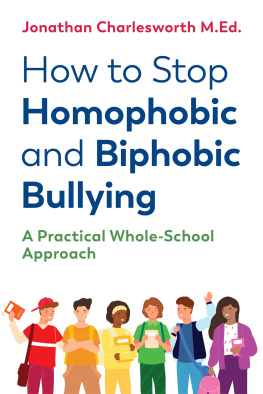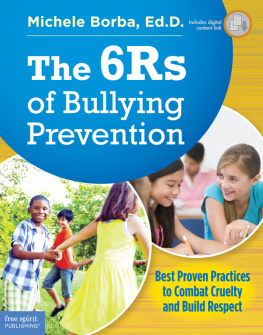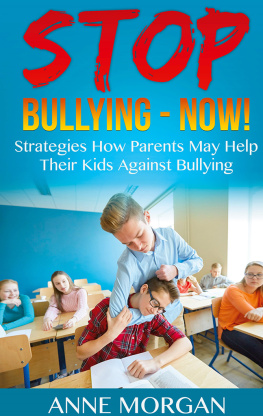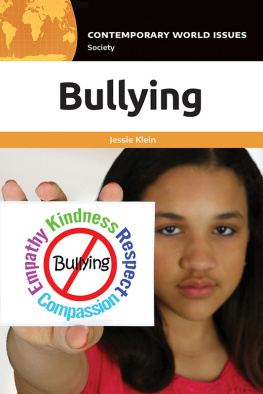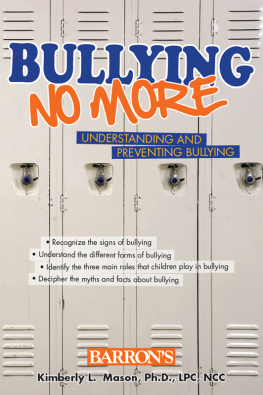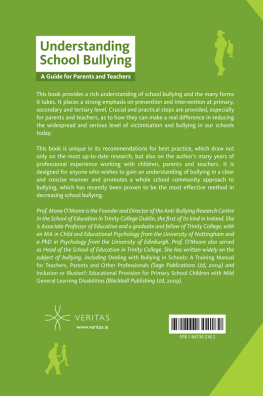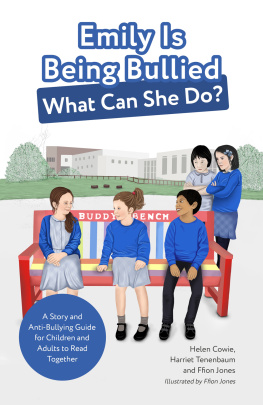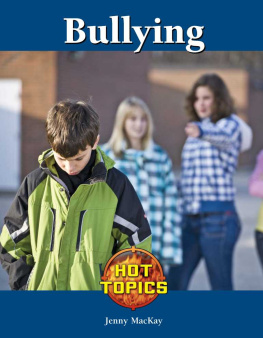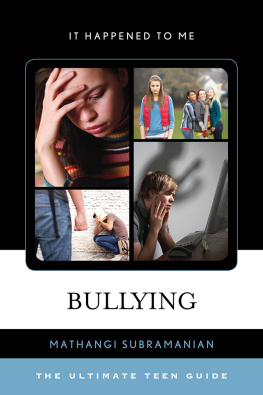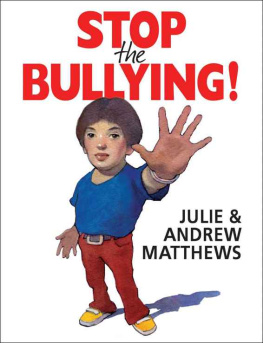Contents

How to Stop
Homophobic and
Biphobic Bullying
A PRACTICAL WHOLE-SCHOOL
APPROACH
Jonathan Charlesworth M.Ed.
Foreword by Peter K. Smith

Contents
Foreword
Unfortunately, homophobic and biphobic bullying are prevalent in schools in the UK and internationally. A vital part of education is to confront prejudiced views and behaviours whether about sexual orientation or identity, ethnicity, faith, gender, or disability such as are manifested in prejudice-based or bias bullying. Schools should be a safe place for learning. In addition they should be imparting the values of tolerance of difference and helping others, as part of being a good citizen in later life.
Fortunately, this book by Jonathan Charlesworth will be an invaluable asset, so far as homophobic and biphobic bullying is concerned. When I read it I was impressed by the careful and balanced way it is written and the very systematic way in which he presents material. He naturally starts with a thorough description of what these kinds of bullying entail, who gets involved and some of the reasons why it can happen. He then describes the impact of being a target of such behaviours. We know from extensive research that targets of school bullying can experience anxiety, depression, feelings of loss of self-worth and even suicidal thoughts and behaviours. This is not inevitably so. It depends on how long and severe the bullying is, and some pupils have more support from friends or family, or more inner reserves of strength, and can come through relatively unscathed. But for the majority of targets there are adverse effects from mild to moderate to very severe: sometimes lasting into adult life. These are educational and health issues that cannot be ignored.
Dealing with homophobic and biphobic attitudes, and bullying behaviours, is one important part of this broad challenge. The second part of this book gives comprehensive help and advice for teachers, parents and others faced with these issues. This includes ways of supporting targets, ways of working to change those who are doing the bullying and broader issues around school policies and government requirements and guidelines. Homophobic and biphobic bullying can raise sensitive issues and bring up a range of attitudes about how best to deal with it. The author is aware of this, and writes sensibly and with consideration, without shirking the need to act firmly and decisively when the situation requires it. I would recommend this book as an excellent and authoritative guide: a book which hopefully every school will purchase, and use, as a support in how they work around these issues and with pupils involved in these kinds of behaviours.
Peter K. Smith
Goldsmiths, University of London
March 2020
Preface
This book is an explanation of and a practical guide to challenging homophobic or biphobic language, name-calling and bullying. I have used variously the words, lesbian, gay and bisexual throughout the book. Unless I am making a specific point about, say, bisexuality, any use of the three applies equally to the other two and homophobia includes biphobia and lesbophobia.
Although homophobia and transphobia can look alike, the issues of sexuality and gender identity are discrete. There is often a case for viewing the issues pertinent to lesbian, gay, bisexual and transgender people collectively but homophobic bullying and transphobic bullying come from different places. Challenging transphobic bullying warrants its own focus in a dedicated book and this is why it is not included in How to Stop Homophobic and Biphobic Bullying . At the end of this book, you will find signposting to resources which should help you address transphobic bullying.
Throughout the book, parents includes grandparents, carers and guardians. Pupils includes learners and students. Governors includes trustees. Sexuality and sexual orientation are used interchangeably. The named audience throughout this book is schools but if you are a college tutor, youth worker, university lecturer, or someone who works in any childrens service, the messages are equally applicable to your own work and young people.
Introduction
Since the first edition of this book in 2015 we have seen the introduction of new Relationships and Sex Education (RSE) in England in September 2019, which is mandatory in all schools from September 2020, the drafting of new Relationships and Sexuality Education which will come into effect in Wales in 2020 and the Welsh Governments publication of Rights, Respect, Equality: Guidance for Schools: Statutory Anti-Bullying Guidance to all its schools in November 2019. The Department for Education (2017c) launched its Preventing and Tackling Bullying guidance in July 2017 and the 2019 Ofsted framework furthers its commitment to treating pupil wellbeing as a measure of success, citing the prevention of bullying (including homophobic and biphobic bullying) and effective provision of RSE and personal, social and health education (PSHE) as key measurements.
In 2017, Turings law posthumously pardoned thousands of gay men convicted of offences that criminalised same-sex activity (Bowcott, 2017). 2019 saw the introduction of equal marriage rights in Northern Ireland. Lesbian, gay and bisexual people have more representation in mainstream media. Reports of anti-gay and lesbian hate crimes however, doubled in the five years between 2014 and 2019 (Marsh, Mohdin and McIntyre, 2019). Gay conversion therapy is still legal in the UK, and schools teaching about families with lesbian, gay or bisexual parents face protests (Ashenden and Parsons, 2019). Seventy per cent of lesbian, gay, bisexual and transgender (LGBT) people have been sexually harassed at work (Trade Union Congress, 2019), while public acceptance of gay sex is falling for the first time since the AIDS crisis (Booth, 2019).
These society-wide issues affect our pupils, contributing to homophobic bullying being the most common form of bullying in schools (BBC, 2019). Seventy-one per cent of teachers report witnessing homophobic bullying and 31 per cent report witnessing it at least once a month (Sky News, 2019).
Although one would think schools would be places where one would see lots of discussion and ground breaking when it comes to equalities issues they are actually largely conservative places that are invariably behind change, seldom ahead of it. This is why issues of sexuality rarely get discussed except when raised by forward-looking teachers who usually have a personal connection with the issue which has brought it into their consciousness or there is a problem with which to be dealt.
Since 1999, UK society has witnessed landslide and welcome legislative changes advancing equalities rights and creating a more equal workplace for people who are gay. Legal improvements have increased gay peoples sense of belonging to mainstream society rather than feeling, as they have for too long, invisible, excluded and often ostracised from it.
We have seen this change reflected in media, television, film and advertising. One of the results of this is that gay young people are more confident about coming out (acknowledging being gay, lesbian or bisexual) while pupils at school rather than waiting until they are in the workplace or at college or university.
Parents dont know if their child is heterosexual so it contradicts the argument that children are too young to attend the LGBT group. (Daisy, 13)

